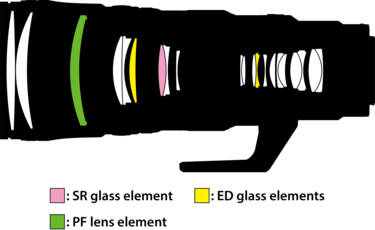What’s inside a Z mount camera lens?

Elements, coatings, motors… What are they and what do they all do? Welcome to lens construction 101
Since the invention of the camera lens in 1839, there have been many innovations as manufacturers raced to create lenses that resulted in better, sharper images and gave more creative control to the person behind the camera.
NIKKOR has been at the forefront of lens development and evolution for 90 years and, with the Nikon Z mount, continues to lead the way.
New NIKKOR Z mount lenses are marvels of modern optical engineering, but the central principle remains the same – using pieces of glass to bend light. Looking at a camera lens, many people could be forgiven for thinking that it’s like a telescope, with a lens at the front and then a long barrel for the light to travel through until it hits the sensor. Nothing could be further from the truth. Modern camera lenses contain a number of glass ‘elements’ of different shapes and with different properties in order to create optimum results. Some of these elements also have special coatings that enhance performance of the lens in different ways. In fact, a camera ‘lens’ is actually made up of many different lenses, all working together. Add to that electrical motors for autofocus, the aperture iris to control how much light enters the lens and a Vibration Reduction system, and a professional camera lens is an incredible feat of both science and design.
Nikon Team
Inside the lens
The NIKKOR Z 600mm f/6.3 VR S, for example, takes full advantage of the Nikon Z mount and is therefore much lighter and smaller than other super-tele lenses. As for the specs? It has 21 elements in 14 groups, including two ED elements, one SR element, one PF element, elements with a Nano Crystal coat and a fluorine-coated front lens element. But what does it all mean? Let’s dig in and find out.
21 elements
This means the lens contains a total of 21 individual pieces of glass, all of which have been built to exacting standards in order to work together.
14 groups
Some of the lens elements are on their own inside the lens, whereas a group is where two (or more) elements are joined together. Groups are created so that they become a perfect marriage of elements working in harmony to achieve the best passage of light through the lens while minimising defects and imperfections. So, the NIKKOR Z 600mm f/6.3 VR S has 21 individually made pieces of glass inside, but some are connected to each other to make up a total of 14 groups. Groups are also connected to the internal autofocus motors in the lens to ensure fast, accurate focusing.

ED elements
NIKKOR’s Extra-low Dispersion lenses all but eliminate ‘chromatic aberration’, where colours look distorted around the edges of an object in a picture. ED elements are better at focusing on the entire colour spectrum and produce incredibly sharp, high-contrast images.
SR elements
SR stands for Short-wavelength Refractive, and these elements control light waves with shorter wavelengths, again severely reducing chromatic aberration.
PF element
PF stands for Phase Fresnel, a technology developed by NIKKOR that not only reduces chromatic aberration but also makes it possible to create a smaller and lighter lens. The PF element has incredibly precise ridges on the surface in the shape of concentric circles (a bit like the lens you would see on a lighthouse) that bend light in very specific ways.
All these ED, SR and PF elements combine to ensure that all the colours of light of different wavelengths come to focus at the same point on the focal plane.
Nano Crystal coat
This is a lens coating made of ultrafine particles that eliminate reflections inside the body of the lens as the light passes through it. This reduces effects called ‘ghosting’ and ‘lens flare’, where reflections (often of a light source at the side of the image) appear as circles of light.
Fluorine coat
A fluorine coat on the front of the lens serves two purposes. First, it is anti-reflective, giving sharper images, but its main job is keeping the lens clean. Fluorine coatings repel dust, dirt, water droplets and grease marks, keeping the lens clear in the harshest of environments.

VR
NIKKOR’s Vibration Reduction technology uses sensors within the lens to detect vertical and horizontal movement. These send information to a computer inside the lens, which then compensates for the movement by using motors to make minute adjustments to lens elements. The system can detect if you’re using a tripod, recognise if you are panning and deal with the specific movements you get when trying to take images or video from a moving vehicle. Synchro VR means the lens has its own VR but also works win the camera’s VR system to increase movement compensation even further.
S
This designates the lens as a pro-level, NIKKOR S-line product. For a full breakdown of what makes an S lens, click here.
And there you have it. Modern NIKKOR Z lenses are pieces of cutting-edge technology, containing the results of 90 years of experience, innovation and expertise – all to make your images sharper and better while giving you more and more creative options.
Check out the full range of NIKKOR Z mount lenses here.
More in technology and know-how
Discover the NIKKOR Z 600mm f/6.3 VR S
Inside the numbers on the new NIKKOR Z 600mm f/6.3 VR S super-tele

Unlock greater creativity




